Tom Sponheim (talk | contribs) |
Tom Sponheim (talk | contribs) |
||
| Line 83: | Line 83: | ||
{| |
{| |
||
| − | |- |
||
| − | |[[Image:Wire_stand.jpg|150px]] |
||
| − | |Dr. [[Steven Jones]] found that raising the pot on a wire frame improved cooking in a panel cooker. |
||
|- |
|- |
||
|[[Image:Wire_frame_to_keep_normal_plastic_bag_from_melting.jpg|150px]] |
|[[Image:Wire_frame_to_keep_normal_plastic_bag_from_melting.jpg|150px]] |
||
Revision as of 20:20, 12 September 2009
Whether you're planning a science project or are just a solar cooking enthusiast, Solar Cooker International wants you to know that your research can help extend the world's knowledge of solar cooking and be of great help to people around the world. You should be aware that it's easy to build a high-performance solar cooker if you have access to modern materials. However, the more than a billion poor people in the world, who could really benefit from having a solar cooker, don't have access to such materials. This means that your research will be most useful if it concentrates on the simplification of cooker design or on the use of low-tech, local materials.
Here are some ideas for areas of research. We will post your findings on this page if you let us know what you found out. We are also interested in adding new areas of research to this list. Please edit this page to add your results or to pose new questions.
General Cooker Features / Improvements Needed
- Better means of heat storage, longer cooking after sunset
- More efficient usage of space
- Going longer without needing to be turned (largely a matter of cooker geometry)
- Water resistance, general durability
Semi-General
What is the simplest way to make a thermometer that could show when water has reached a temperature that would kill any microbes in it and make it safe to drink?
Throughout the world it is mistakenly believed that unsafe water needs to be boiled for 20 minutes to make it safe to drink. Bacteriological tests in the field have confirmed that it is only necessary to bring the water to 65° C (149° F) to make it safe to drink. It is easy to see when water is boiling so no temperature measurement in needed. However, it is not easy to see when water gets to 65° C. What is needed is a simple method that is available to poor people around the world to indicate when this temperature has been reached.
- Solar Cookers International has designed the Water p\Pasteurization Indicator (WAPI) for this purpose, but this design makes use of a high-tech petroleum fat to indicate temperature.
- It might be possible to use beeswax to indicate this temperature in place of the petroleum fat.
- Matthew Collier has adapted an idea by Galileo here.
- A document explaining various methods to make thermometers from simple materials is here.
- Philip Guest has this suggestion: Woods metal is an alloy of Bi (50%), Pd (25%), Sn (12.5%), and Cd ( 12,5%). This has a melting point of 346 Kelvin, (70C). Sounds complex, but a lot of modern golf club drivers contain the alloy for its mass, encapsulated in a strong sealed vile it should be safe, e.g. Pyrex. Recycle those clubs, find an ethical manufacturer, and were away, costs should be small, and can be started in most developed countries. Logistic problems, storage and distribution but this could be coordinated. A test tube and a bung could suffice.
- Philip Guest had another suggestion: Methanol boils at 65°C. One could design a vial that is dynamically unstable so that it would fall over if the methanol in it goes above its boiling point.
- William Nix suggests a Thermometer using egg yolk to indicate temperature.
Does placing contaminated water into clear plastic bottles and exposing the water to the sun (not inside a solar cooker) actually make it safe to drink?
There is a technology called SODIS being promoted around the world for this purpose. There is some doubt about whether this really makes the water safe to drink. A good science project would be to test this by using toilet water and measuring using the Colilert System.
Could you use solar energy to melt together shredded plastic bottles to make a waterproof panel that could be used to construct a CooKit or other solar cooker?
- This might be easily done with some plastics but not others. What type of plastic bottle is in mind? Does it have to be shredded or can it be cut into a few larger pieces? If polyethylene, polycarbonate, PMMA, or polypropylene, this should be easy. Polystyrene, on the contrary, gives off the worst smell imaginable when hot, and has a fairly difficult-to-reach melting point of 240oC. Unfortunately, polyethylene terephthalate is even worse, and many plastic bottles are made of it. A basic design for melting "good" plastic could be the Solar Pocket.
- SolarCycle has developed a technology to convert waste plastic bags into panels that are then lined with reflective material from the inside of potato chip bags.
Box Cookers
How does a sheet of plastic film (like an oven cooking bag) compare with a sheet of glass for the glazing? Does a double sheet of plastic film equal a single sheet of glass? Do windy conditions effect plastic film more than glass?
- Here are the findings of Ajit Kumar N Shukla.
- It should be mentioned that most oven cooking bags are substantially less transparent than that. As a rule, if things look noticeably dimmer, foggy or off-colored when viewing through 2-3 layers of the plastic, it is not good. Plexiglass works, if it will not go above 120oC (248oF). For many other types of solar cookers, such as panel cookers, oven cookings bags work reasonably well.
How does cooking in a clear jar compare with cooking in a jar that has been painted black?
- Michael Michalowicz found that painting the jar black increased efficiency by 6%.
- Arthur Stamey-Mills performed a side-by-side test where he heated water in a black pot and in a clear pot. The black pot heated the water to a temperature that was 18% higher than in the clear pot.
How can you make a dark paint that poor people around the world can make using simple materials (ash, egg white, sap, wheat paste, etc.).
- Shannon Cox suggests blackening the outside of the pots over a fire. She has aluminum army mess kits and they turned black the first time she used them cooking over a fire. We are aware that this can work. It would be nice to know how long this takes and if there are ways of quickening the process.
- Håkon Kjernli writes, "As a kid, I read an advice for blackening metal: dip it in linen seed oil and hold it into a fire. The oil burns and leaves a solid black color, similar to what you get on an old open-fire cooking pan. I guess any kind of oil or fat will do the job. Do this a few times and as I recall, you should have a very durable black coating which does not insulate or crack. I have not tried it for 30 years, but I will the next time I sit by a fire with a piece of metal and some fat or oil nearby."
How could a simple mechanism be designed that would automatically turn the cooker after a few hours?
See Solar tracking.
Should the walls inside the cooker be foiled to reflect the light, or should they be painted black?
- Ethan discovered in his science project that an empty oven with shiny walls and a steel plate on the bottom got 8% hotter than the others he tried.
- The cooker without foil shown in this picture was able to pasteurize water.
How can you waterproof cardboard (beeswax, oil, etc.)?
- One participant found that using gelatin worked very well to water-proof cardboard.
Panel Cookers
How much does cooking without a plastic bag diminish the cooking capacity of a panel cooker?
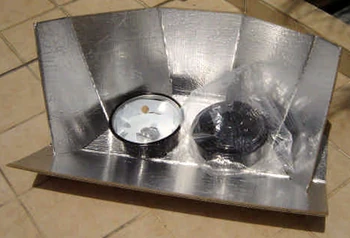
Teong Tan found that a black pot with a clear lid without a plastic bag heated faster than a normal dark pot with a dark lid inside a plastic bag. See Greenhouse enclosure comparisons
- If it is windy or partly cloudy, and probably even if it isn't, this surely leads to very slow cooking or none at all. I have not even seen a pot reach cooking temperatures at all this way. Unless there are many panels (more than 10), I have a hard time believing it will get any hotter than an ordinary black surface perpendicular to the sun's rays. Remember, the sunlight has to strike each side of the pot separately, including the bottom, and each reflector only bounces light onto one side of the pot. From my experience, this method is difficult at best.
- In a side-by-side water heating test, Arthur Stamey-Mills found that a pot enclosed in a plastic bag heated the water to a temperature 30% higher than did a pot without a plastic bag.
How can plastic bags be made to last longer? Should they be held away from the hot pot using some sort of frame?
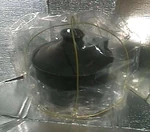
|
Wietske Jongbloed created a simple frame to allow the use of normal plastic bags (instead of heat-resistant oven cooking bags). |
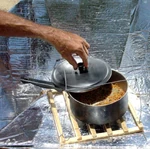
|
Jose Albano created this frame to protect normal plastic bags (photo shows frame with bag removed). |
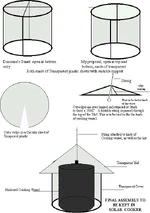
|
Mr. Diasanna of Nigeria had also suggested using a simple wire frame to allow the use of normal plastic bags. Dr Ashok Kundapur has slightly refined the arrangement as shown in the diagram. Here plastic sheeting is supported by wire frame while a transparent cover, made of the same plastic material, makes access to the food very easy. This arrangement can also be used for retained-heat cooking. |
Is it possible to create a pot assembly with a dark inner pot, a clear outer pot, and a vacuum in between
Using this configuration, the sunlight would be able to enter, but the heat would be stopped from escaping by the vacuum. This could greatly improve cooking efficiency. For information on this, watch this video.
Does it help to raise the pot off the ground? If so, what should you use to lift it? Should the lifters be place inside the plastic bag or outside?
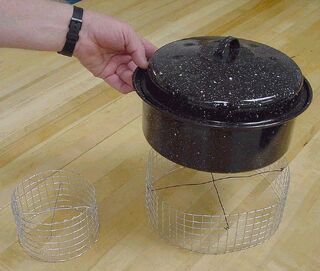
Dr. Steven Jones found that raising the pot on a wire frame improved cooking greatly.
How much does a double bag improve cooking?
- This depends on the transparency of the particular bag being used, as well as the thickness of the air gap and how well the air is held in place. It will probably be a worthwhile improvement as long as the bags are reasonably transparent, but a little opacity goes a long way in degrading performance. As a rule, if things look noticeably dimmer, foggy or off-colored when viewing through 2-3 layers of the plastic, it is not good.
How should you arrange it so multiple pots could be used (stacking, side-by-side, etc.)?
- Ravindra Pardeshi sent the results of his testing and it is posted here.
What materials could be used to build the cooker besides cardboard? Papier-mâché?
Could you use one plastic bag around the base of the pot and another smaller one over the lid, thus allowing the pot to opened during cooking without opening the bag?
Does the bag have to go all the way around the pot, or could it fitted with a frame to keep it open and just be lowered over the pot like a dome?
Other needs
- Unbreakable lightweight metal pressure vessel, similar to glass “canning” jars
- Vessels designed for use with parabolic concentrators, including shapes, surfaces and glazing.
- Inexpensive durable high performance reflective materials. Example: metalized Mylar®.
- Develop a long-lasting bag for the CooKit and other panel cookers.
